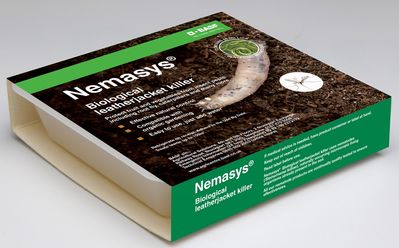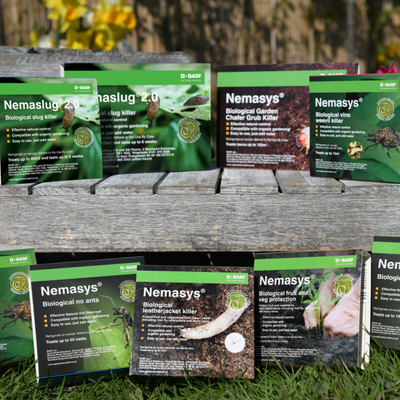Protect Lawns from Problematic Pests this Autumn
Published:
Read Time: 3 mins
As the summer season winds down and autumn approaches, now is the time to plan ahead and protect lawns from leatherjackets, the larvae of crane flies, otherwise known as daddy long legs!
Crane flies lay eggs between August and October, these eggs take only two weeks to hatch and become root-munching grubs. Applying nematodes from late summer can help combat the lawn damage caused by them. Here, Matt Martin from Nemasys has shared the best practices for protecting lawns and treating leatherjacket infestations before they get out of hand this autumn.
How to Tell if You Have a Leatherjacket Infestation
The easiest way to tell if you have a leatherjacket infestation is to find a grub — they’re not too hard to spot! They have long, elongated tubular bodies and can grow up to 30mm. They have no obvious head or legs and can be brown or black in colour. To encourage them out of the lawn, you can saturate the grass and cover it with black sacks or tarpaulin overnight.
In the morning, the grubs will have risen to the surface and will be easy to see. They can be discarded by picking them off by hand or leaving them exposed for hungry birds to consume. With severe infestations, it is possible to lift the first layer of soil with a shovel or trowel and spot the critters wriggling around just below the surface!
Another way to tell if the lawn is suffering from a leatherjacket infestation is all within how it looks. Leatherjackets feed on the roots of the grass, leaving it lacklustre, yellow and thin. Without intervention, the lawn will be completely deteriorated which can be hard to bring back to life.
Prevention is Better Than a Cure
Taking a proactive approach to lawn care is the best way to prevent a large-scale infestation of leatherjackets. Applying nematodes is a great, biological way to banish grubs and keep the lawn looking luscious during the key leatherjacket season. Nemasys Biological Leatherjacket Killer targets and kills leatherjacket larvae by entering the grubs’ bodies through natural openings and pores, ensuring the problem is dealt with at the source.
Nematodes only attack their intended prey and will not harm beneficial insects, focusing solely on the leatherjacket grubs. Extra protection this year is particularly crucial as the increase in wet weather is expected to cause a boom in leatherjacket populations, but gardens with dense soil or clay lawns, often found in new build homes, are especially susceptible to these troublesome pests, making prevention even more important.
Optimal Application Timing
The best time to apply Nemasys Leatherjacket Nematodes is typically from late August to early October, depending on local weather conditions. During this period, leatherjackets are still in their larval stage and close to the surface, making them more susceptible to nematode attack. To ensure maximum effectiveness, Nemasys recommends the following lawn care practices:
1. Monitor Soil Temperature: Leatherjacket nematodes thrive and are most effective in soil temperatures between 10°C and 30°C (50°F and 86°F). Monitor your lawn’s soil temperature regularly to ensure it falls within this range before application.
2. Proper Watering: Ensure your lawn is well-watered before and after the nematode application. Moist soil encourages nematode activity and movement, enhancing their ability to seek out and infect leatherjackets.
3. Timing Matters: Apply Nemasys nematodes in the early morning or late evening when the soil is cooler as there’s less risk of the nematodes being harmed by UV rays.
To find out more about how nematodes work, take a look at this short video
- https://youtu.be/JHNG1KSluh0
For further information please visit https://www.nemasysinfo.co.uk/
and follow @basf_nemasys_uk on Instagram for more top tips and advice on using beneficial nematodes in the garden.
Ends
Editors notes
Nematodes are naturally occurring microscopic worms, already present in our soil. Beneficial nematodes attack and kill targeted garden pests. They are compatible with organic farming, easy to use and can even be kept in your fridge!
Research scientists have isolated the nematodes that kill specific garden pests including Slugs, Vine weevils, Leatherjackets, Caterpillars, Codling moth and much more.
BASF’s state of the art production facility in the UK produces billions of nematodes in a form that is easily applied by gardeners. Over 20,000 different species of nematodes have been classified, although some estimates put the total figure closer to one million! BASF has the largest specialist nematode production facility in the world, growing trillions of beneficial nematodes for use in their Nemasys range of pest control products.
BASF experts are available for interviews, features and expert comment on biological pest control management, and product is available for reviews, competitions and product trials.






